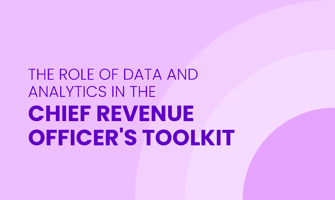Chief Revenue Officers (CROs) rely on data and analytics to drive growth and maintain revenue...
Common Challenges for Chief Revenue Officers and How to Overcome Them
Chief Revenue Officers (CROs) are important for driving a company's revenue growth and achieving business success. They manage sales, marketing, customer experience, and all customer-facing operations, facing numerous challenges that can significantly impact performance and the bottom line.
This article aims to highlight the common challenges CROs encounter and provide practical strategies to overcome them. You learn how to navigate these obstacles effectively, leveraging data-driven insights and strategic approaches to ensure sustained growth and maintain a competitive advantage in the market.
The Significance of Addressing Challenges in the CRO Role
The Chief Revenue Officer (CRO) oversees sales, marketing, customer experience, and all customer-facing operations. CROs play a key role in unlocking market potential, driving growth, and meeting revenue targets. However, this role comes with significant challenges that must be addressed to succeed.
Successfully handling these challenges requires agility, data-driven strategies, and strong leadership. CROs need to adapt to market changes, use data to make smart decisions and guide their teams through various obstacles. Addressing these challenges is essential for not just surviving but thriving in today’s competitive business environment. This approach ensures continued growth and a strong position in the market.
Common Challenges CROs Face and Their Solutions
1. Adapting to Changing Buyer Behaviors
With the rise of digital channels, customers now demand personalized interactions and seamless experiences. CROs must understand and respond to these evolving expectations to remain competitive in the market.
Failing to adapt to changing buyer behaviors can lead to decreased customer satisfaction and reduced loyalty, ultimately resulting in a decline in revenue growth. Addressing these changes is essential for maintaining strong customer relationships and driving revenue.
How to Overcome This Challenge
-
Conduct Continuous Customer Research: Regularly collect and analyze customer feedback to understand evolving preferences. Use surveys, focus groups, and social media listening tools to gather insights, enabling you to tailor strategies to meet customer expectations effectively.
-
Implement Advanced CRM Systems: Utilize sophisticated CRM tools to manage and analyze customer interactions. CRM (Customer Relationship Management) is a system for managing a company’s interactions with current and potential customers. These systems help in creating detailed customer profiles, allowing for personalized and timely engagement that can enhance customer loyalty and satisfaction.
-
Leverage Data Analytics: Employ advanced analytics to gain deep insights into customer behavior and predict trends. Use this data to inform decision-making and customize marketing campaigns, ensuring they resonate with your target audience.
-
Adopt Omnichannel Strategies: Omnichannel means providing a seamless customer experience across all channels. Ensure consistency between online and offline interactions, integrating touchpoints to offer a cohesive and satisfying customer journey.
![]()
2. Integrating Advanced Technologies
Choosing and integrating the right technologies is a process that involves selecting suitable tools and also ensuring they work seamlessly with existing systems.
Poor integration of advanced technologies can lead to operational disruptions, reduced productivity, and missed revenue opportunities. So, a strategic approach to technology selection and integration is crucial for achieving business goals.
How to Overcome This Challenge
-
Stay Updated with Technological Trends: Regularly review emerging technologies to identify those that align with your business objectives. Attend industry conferences, subscribe to tech journals, and network with peers to stay informed about the latest innovations.
-
Build a Scalable Technology Ecosystem: Develop a flexible technology framework that can grow with your business needs. Start by assessing current infrastructure, identifying gaps, and selecting scalable solutions that integrate well with existing tools.
-
Ensure Seamless Integration: Select technologies that easily integrate with your current systems. Collaborate with IT teams to facilitate smooth integration processes, minimizing operational disruptions and ensuring all tools work harmoniously.
-
Invest in Comprehensive Training Programs: Provide thorough training for staff to ensure they can effectively use new technologies. Continuous education helps maximize the potential benefits of technological investments, enhancing overall efficiency and performance.
3. Navigating Digital Transformation
CROs face the challenge of leading their organizations through digital transformation. This involves redefining core business processes and removing outdated systems.
Failing to navigate digital transformation can result in operational inefficiencies, loss of competitive edge, and missed growth opportunities. Addressing these challenges is crucial for staying relevant in the digital age.
How to Overcome This Challenge
-
Develop a Clear Vision and Strategic Roadmap: Use tools like SWOT (Strengths, Weaknesses, Opportunities, Threats) analysis to assess current capabilities and identify areas for improvement. Tools such as Gantt charts and project management software can help in creating detailed roadmaps with specific milestones and timelines.
-
Cultivate a Mindset of Innovation: Implement brainstorming sessions and innovation workshops to encourage creative thinking within the team. Utilize techniques like design thinking to develop new solutions and strategies.
-
Pilot New Initiatives: Start with small-scale pilots for new digital initiatives. Agile project management techniques, such as Scrum or Kanban, involve iterative testing, learning, and adapting before scaling up. This approach reduces resistance and increases enthusiasm for new capabilities. Agile methodologies focus on flexibility, customer feedback, and small, incremental improvements.
-
Encourage Agility: Train staff in agile methodologies to enhance flexibility and responsiveness. Techniques such as regular sprint reviews, daily stand-ups, and retrospectives can help teams adapt quickly to changes and continuously improve processes.
4. Balancing Short-term and Long-term Goals
Balancing immediate sales targets with nurturing future growth opportunities is essential for CROs. The pressure to deliver short-term results can often overshadow long-term strategic planning.
Neglecting long-term goals in favor of short-term gains can lead to unsustainable growth and missed opportunities for future success. It's essential to strike a balance to ensure sustainable business growth.
How to Overcome This Challenge
-
Set Dual KPIs: Define key performance indicators (KPIs) that measure both short-term achievements and long-term progress. Tools like the Balanced Scorecard can help balance metrics effectively, such as current sales figures versus customer lifetime value. Objectives and Key Results (OKRs) can be used by setting clear objectives and defining measurable key results to track both immediate and long-term goals.
-
Regularly Adjust Strategies: Implement regular strategy review sessions to assess and realign goals based on current performance and market conditions. Use strategic planning tools like Objectives and Key Results (OKRs) to maintain focus on both immediate and future objectives. OKRs involve setting clear, achievable goals and defining measurable results to track progress.
-
Communicate Vision: Hold regular meetings and updates to share the company's vision and goals with the team. Use visual aids like strategy maps to illustrate how short-term actions contribute to long-term success.
-
Prioritize Resource Allocation: Conduct resource planning sessions to ensure adequate support for both short-term projects and long-term initiatives. Use project management tools like Gantt charts to visualize and balance resource distribution.
5. Leveraging AI for Sales and Marketing
Artificial intelligence (AI) can optimize sales and marketing processes, but CROs often struggle with effective integration. Properly utilizing AI can lead to better customer insights, personalized marketing, and improved sales forecasting.
Ineffective AI integration can lead to wasted resources and missed growth opportunities. Successfully leveraging AI is crucial for enhancing sales and marketing efforts.
How to Overcome This Challenge
-
Identify High-Impact Areas: Focus on areas where AI can drive the most value, such as predictive analytics for sales forecasting or customer segmentation for personalized marketing. Techniques like machine learning can analyze customer data to predict future buying behaviors, allowing for more targeted marketing efforts.
-
Ensure Proper Data Management: Implement robust data management practices, such as data cleansing, data integration, and establishing data governance policies, to maintain clean, high-quality data. This ensures accuracy and reliability, which are essential for effective AI applications. To navigate these challenges effectively, CROs can leverage comprehensive solutions like those offered by 180ops to integrate and manage data efficiently.
-
Start with Small-Scale Projects: Begin with pilot projects to test AI applications and gather insights. Techniques like agile project management can help in iteratively testing and refining AI initiatives, allowing for gradual scaling based on successful outcomes.
6. Aligning Sales and Marketing Efforts
Sales and marketing teams often operate in silos, leading to misaligned strategies and missed opportunities. Effective alignment between these teams is essential for maximizing revenue and ensuring cohesive efforts.
Without alignment, there can be inefficiencies and lost revenue opportunities. Bringing sales and marketing together ensures a unified approach to achieving revenue goals.
How to Overcome This Challenge
-
Establish Clear Communication Channels: Implement regular meetings and collaborative platforms to facilitate communication between sales and marketing teams. Techniques such as weekly alignment meetings and shared project management tools can ensure both teams are on the same page.
-
Set Shared Objectives: Define common goals and key performance indicators (KPIs) that both teams work towards. Techniques like setting SMART (Specific, Measurable, Achievable, Relevant, Time-bound) goals ensure both teams have clear, aligned targets.
-
Develop Joint Strategies: Create integrated go-to-market strategies involving both teams from the planning stage. Use techniques like co-creating customer journey maps to ensure both teams understand their roles in achieving shared objectives.
![]()
7. Managing Economic Uncertainty
Economic uncertainty can lead to reduced spending and delayed decision-making, posing challenges for revenue growth. CROs must navigate these periods with strategic planning and adaptability.
Failing to manage economic uncertainty can result in lost revenue and missed opportunities. Adopting strategies to mitigate risks is essential for maintaining stability during volatile times.
How to Overcome This Challenge
-
Diversify Revenue Streams: Explore new markets, products, or services to reduce reliance on a single revenue source. Conduct feasibility studies, which involve evaluating the practicality and potential success of new ventures through market research, cost analysis, and risk assessment. By diversifying, companies can spread risk across multiple income sources, ensuring that a downturn in one area does not severely impact overall revenue.
-
Revisit Pricing Strategies: Adjust pricing models to stay competitive while protecting margins. Implement dynamic pricing, which adjusts prices based on current market demand, and value-based pricing, which sets prices according to the perceived value to the customer. Use pricing optimization tools to analyze market data and customer behavior, allowing for more responsive and strategic pricing decisions that can maximize revenue during uncertain times.
-
Monitor Market Indicators: Stay attuned to economic trends and market signals to anticipate changes. Use tools like economic forecasting models and real-time data analytics to make informed strategic adjustments. Regularly review financial reports, consumer behavior data, and industry forecasts to stay ahead of potential economic shifts. This proactive approach helps in adjusting strategies promptly to mitigate risks associated with economic volatility.
-
Enhance Operational Flexibility: Increase the organization’s ability to adapt quickly by streamlining processes and investing in flexible technologies. Use techniques like lean management to eliminate inefficiencies and improve responsiveness to market changes. Encourage a culture of agility within the team, where quick decision-making and iterative improvements are prioritized. This flexibility ensures the organization can pivot strategies as needed to respond effectively to economic uncertainties.
![]()
Conclusion
The role of the Chief Revenue Officer is complex and demanding, with a need to manage various challenges that can impact a company's performance. By approaching each challenge with strategic insight, data-driven solutions, and an unswerving commitment to adaptation and improvement, CROs can guide their organizations to new heights.
Overcoming these challenges is pivotal to not only driving revenue but also establishing a resilient and forward-looking operation that thrives amidst the dynamism of the business landscape.
In the end, a CRO's ability to turn challenges into opportunities will define their success and the growth of their organization.
FAQs
How do market conditions impact a Chief Revenue Officer's (CRO) strategy?
Market conditions significantly influence a CRO's strategy by dictating the demand for products or services, affecting pricing strategies, and shaping competition. Understanding and adapting to changing market conditions is crucial for maintaining a competitive edge and achieving business growth.
What are the best practices for business operations to improve customer retention?
To enhance customer retention, CROs should focus on optimizing business operations to deliver excellent customer experiences. Implementing effective data management practices helps in understanding customer behavior, while continuously improving processes ensures that customer needs are consistently met. Additionally, developing strong customer retention strategies, such as personalized engagement and loyalty programs, can significantly increase retention rates.
How can CROs effectively attribute revenue in their organizations?
Revenue attribution involves tracking and analyzing the sources of revenue within an organization. CROs can use advanced data analytics tools and revenue operations strategies to gain insights into which channels, campaigns, or sales efforts are driving the most revenue. Accurate revenue attribution helps in making informed decisions about resource allocation and optimizing the go-to-market process.
What role does pricing strategy play in a company's global expansion efforts?
Pricing strategy is crucial in global expansion as it determines how competitive a company's offerings will be in new markets. CROs must consider local market conditions, purchasing power, and competition when setting prices. Utilizing dynamic pricing and value-based pricing strategies can help in adapting to different markets and maximizing revenue potential during global expansion.
How can CROs balance short-term results with a long-term strategy for sustainability?
Balancing short-term results with a long-term strategy requires CROs to set dual KPIs that measure both immediate performance and long-term growth. This involves focusing on short-term sales targets while also investing in sustainability initiatives and new technologies that ensure long-term success. Continuous process improvement and regular strategy reviews can help align the revenue team's efforts with both short-term and long-term objectives.




